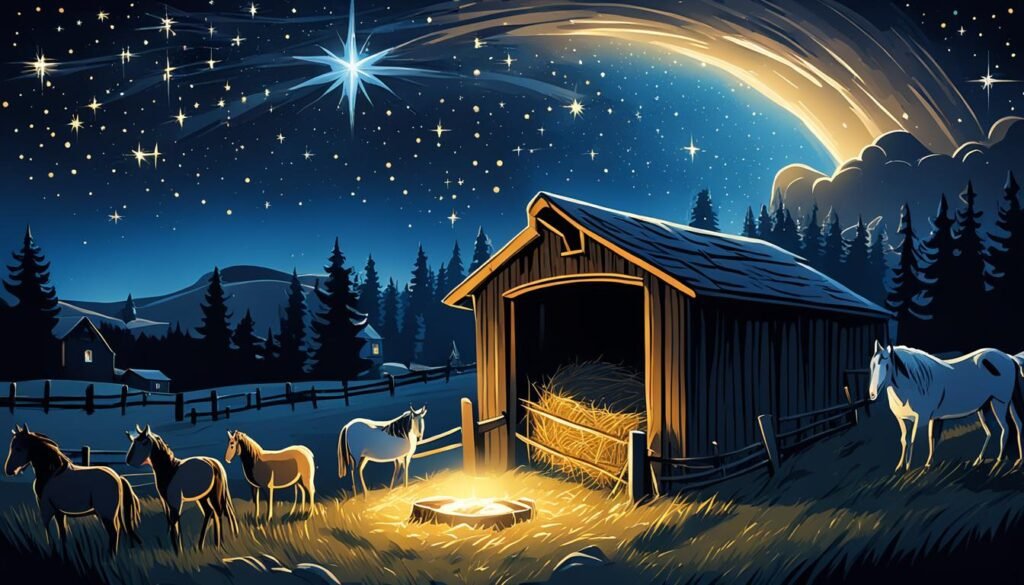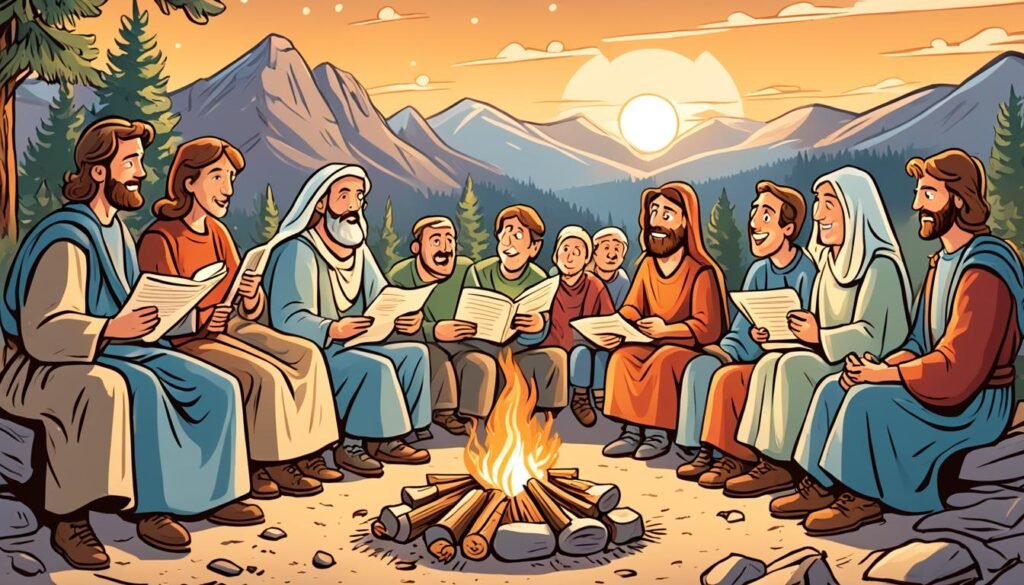The night before Jesus was born holds great significance in Christian tradition. According to the biblical account, this was when Mary and Joseph faced numerous challenges before the birth of their son. Understanding the events leading up to Jesus’ birth provides valuable insight into the true meaning of Christmas.
Mary and Joseph embarked on a journey from Nazareth to Bethlehem, their ancestral home. Arriving in Bethlehem, they faced difficulty finding accommodation, as there were no available rooms in the local inns. This led to an unexpected turn of events that became integral to the story of Jesus’ birth.
Many traditions and additional details surrounding the birth of Jesus have emerged over the years. These traditions often come from the Protevangelium of James, a document written centuries after the biblical accounts. While these traditions may differ from the biblical narrative, they have become part of Christian culture.
Contrary to popular belief, Joseph and Mary had been in Bethlehem for several days before Jesus’ birth. This indicates that they had managed to find shelter prior to the night of the extraordinary occurrence.
It remains a mystery why Joseph and Mary did not secure adequate lodging in Bethlehem. However, it is noteworthy that they had relatives in the area who could have provided them with accommodation. Zechariah and Elizabeth, who were also central figures in the biblical account, lived nearby and could have potentially offered their support.
Key Takeaways:
- The night before Jesus was born, Mary and Joseph faced challenges in finding lodging in Bethlehem.
- Traditions surrounding Jesus’ birth have emerged from the Protevangelium of James, a document written centuries later.
- Joseph and Mary had already been in Bethlehem for several days before Jesus’ birth.
- Relatives, such as Zechariah and Elizabeth, lived nearby and may have been able to provide accommodation.
The Journey to Bethlehem
Mary and Joseph embarked on a long and arduous journey from their hometown of Nazareth to Bethlehem. This journey, which took place during a time when travel was challenging, was prompted by a census decree by the Roman Emperor. Mary, being heavily pregnant, endured the physical discomforts of the journey with Joseph by her side.
Arriving in Bethlehem, the couple faced an unexpected challenge – there were no available rooms in the local inns. Despite their best efforts, they were turned away, leaving them without a proper place to stay.
Forced to seek alternative shelter, Mary and Joseph found refuge in a humble stable. This humble setting would become the birthplace of Jesus, the savior who would go on to change the course of history.
“And she brought forth her firstborn Son and wrapped Him in swaddling cloths, and laid Him in a manger, because there was no room for them in the inn.”
– Luke 2:7 (NKJV)
It is important to recognize the significance of this journey and the circumstances surrounding Jesus’ birth. Mary and Joseph’s challenging journey and their inability to find suitable lodging highlight the humble and ordinary beginnings of the Son of God.
Despite the lack of earthly comfort, this simple and unassuming setting held immense spiritual meaning. It exemplifies the message of humility, redemption, and the inclusivity of God’s love that lies at the heart of the Christmas story.
| Key Takeaways |
|---|
| Mary and Joseph embarked on a challenging journey from Nazareth to Bethlehem. |
| No available rooms in the local inns forced them to seek shelter in a stable. |
| The birth of Jesus in a humble stable highlights the message of humility and inclusivity. |
The Traditions and Misconceptions
Many traditions and additional details about the birth of Jesus have been passed down through generations, contributing to the rich tapestry of Christmas story traditions. While these traditions hold significant cultural and historical value, it is important to acknowledge their origins and potential differences from the biblical account.
One notable source of these traditions is the Protevangelium of James. Written in the third century A.D., this document provides supplementary details about the events surrounding Jesus’ birth. However, it is crucial to recognize that the Protevangelium of James is not a part of the biblical canon and may present variations from the established biblical narrative.
Tradition is the living faith of dead people, not the dead faith of living people.” – Jaroslav Pelikan
Over time, as Christian culture moved to Europe, additional elements and interpretations were incorporated into the Christmas story traditions. These developments were influenced by various cultural influences, artistic representations, and popular beliefs of the time. As a result, some details may differ from the original biblical account, reflecting the creative interpretations and evolving traditions of different regions and periods.
While these traditions and misconceptions contribute to the festive and cultural aspects of Christmas, it is essential to distinguish them from the core biblical narrative. Understanding the origins and potential divergences can deepen our appreciation for the varied interpretations and cultural significance surrounding the birth of Jesus.

| Common Christmas Story Traditions | Biblical Account |
|---|---|
| The presence of three wise men at the birth of Jesus | The Bible does not specify the number of wise men, only that they presented three gifts: gold, frankincense, and myrrh. |
| Animals in the stable witnessing Jesus’ birth | While the Bible mentions Jesus being laid in a manger, it does not explicitly mention animals’ presence. |
| Angels singing at the birth of Jesus | The Bible records the angels announcing Jesus’ birth and praising God, but no mention of them singing. |
| Joseph portrayed as an elderly man | The Bible does not provide an age for Joseph but indicates his engagement to Mary. |
The Arrival in Bethlehem
Contrary to popular belief, Joseph and Mary arrived in Bethlehem days before Jesus’ birth. The Bible mentions that Mary gave birth while they were already in Bethlehem, indicating they had been there for some time.
According to the biblical account, Joseph and Mary traveled from Nazareth to Bethlehem, the city of David, due to a census decreed by the Roman Emperor. They made this journey because Joseph was of the house and lineage of David. The information provided by the census required them to go to Bethlehem despite Mary’s advanced pregnancy.
Upon their arrival in Bethlehem, Joseph and Mary would have sought a place to stay, as it was customary for travelers to find accommodation in an inn or with local families. However, the lack of adequate lodging in Bethlehem presented a challenge for the couple.
The Gospel of Luke states, “While they were there, the time came for the baby to be born, and she gave birth to her firstborn, a son. She wrapped him in cloths and placed him in a manger because there was no guest room available for them” (Luke 2:6-7, NIV).
This passage indicates that Mary gave birth after they arrived in Bethlehem, suggesting that they had been in the city for a period of time before Jesus was born. The reference to the manger also implies that they were staying in a place intended for animals, likely due to the unavailability of suitable accommodation.
In this context, it is essential to understand that the phrase “no room available” does not refer to a traditional inn as we know it today. Instead, it likely refers to a guest room within a private home. During this time, homes in Bethlehem typically consisted of a main living area for the family and a separate guest room where visitors could stay. The guest room would have been already occupied by other guests, leaving Joseph and Mary with no choice but to utilize the stable area.
By examining the biblical account, we can glean that Joseph and Mary’s arrival in Bethlehem occurred prior to Jesus’ birth. The details provided in the Gospel of Luke help to dispel common misconceptions and shed light on the circumstances surrounding the momentous event that took place in Bethlehem.
| Contrary to… | The True Event |
|---|---|
| Popular belief | Arrived on the day of Jesus’ birth |
| Biblical account | Arrived in Bethlehem prior to Jesus’ birth |
| Mary gave birth in an inn | Mary gave birth in a stable |
| No available lodging | No available guest room in a private home |
The Question of Lodging
As the biblical account tells us, Joseph and Mary faced difficulty finding adequate lodging in Bethlehem before the birth of Jesus. The exact reasons for this lack of accommodation are unclear. However, we can speculate that the sheer number of people traveling to Bethlehem for the census may have overwhelmed the available lodging options in the town.
Regardless of the reasons, Mary and Joseph found themselves without a suitable place to stay on that fateful night. They had no choice but to seek shelter in a stable, where Jesus was ultimately born. The image below depicts the humble surroundings of the stable where Jesus came into the world:

While it may seem surprising that Mary and Joseph could not find a more comfortable place to give birth, it is essential to remember the circumstances they were facing. The stable provided them with at least some shelter and privacy during this significant event.
In Bethlehem, where Joseph and Mary arrived, they did have relatives. Zechariah and Elizabeth, the parents of John the Baptist, lived nearby. It is possible that Joseph and Mary reached out to them for assistance, but the biblical account does not provide explicit details on this matter.
The lack of adequate lodging and the necessity of giving birth in a stable are compelling aspects of the birth narrative. This challenging backdrop emphasizes the humility and simplicity with which Jesus entered the world, setting the stage for the remarkable story that would unfold.
Getting the Story Straight
The retelling of the birth story of Jesus is an opportunity to delve deeper into the true meaning of Christmas. It is a chance to uncover the love, sacrifice, and joy of giving that took place on that extraordinary night. By focusing on the care and support Joseph and Mary received from their community, we can fully appreciate the significance of this timeless event.
“For the true meaning of Christmas is the celebration of God’s love and grace manifested through the birth of Jesus Christ.”
Joseph and Mary’s journey to Bethlehem and the circumstances surrounding their arrival have been shrouded in misconceptions. The biblical accounts provide us with a glimpse into their experiences, which were marked by resilience and the unexpected blessings of community support.
To paint an accurate picture of the birth story, it is crucial to separate fact from fiction and focus on the genuine acts of kindness and solidarity that transpired. This will allow us to connect with the profound message of Christmas and embrace its true essence.
Retelling the Birth Story: Unearthing the True Meaning of Christmas
When retelling the birth story of Jesus, it is essential to convey the following key aspects:
- The journey of Joseph and Mary from Nazareth to Bethlehem, showcasing their determination and faith.
- The scarcity of suitable lodging in Bethlehem and the unexpected circumstances that led to Jesus’ birth in a stable.
- The care and support Joseph and Mary received from their community, emphasizing the fundamental values of love, sacrifice, and selflessness.
- The announcement of Jesus’ birth by the angel Gabriel to Mary, highlighting her acceptance of God’s plan and her role as the chosen vessel for the Savior’s arrival.
By focusing on these elements, the true meaning of Christmas can shine through. It is a celebration of divine love, the embodiment of selfless giving, and the ultimate sacrifice made for humanity’s salvation.

| Key Aspects | Description |
|---|---|
| The Journey | Joseph and Mary’s determination and faith as they traveled from Nazareth to Bethlehem. |
| Scarcity of Lodging | The lack of suitable accommodation in Bethlehem that led to Jesus’ birth in a stable. |
| Community Support | The care and support Joseph and Mary received from their community, highlighting the values of love, sacrifice, and selflessness. |
| The Angel’s Announcement | The angel Gabriel’s visit to Mary, announcing the divine plan and emphasizing her acceptance of her role in the Savior’s birth. |
Welcomed into a Private Home
Evidence suggests that Joseph and Mary were taken in by locals upon their arrival in Bethlehem. They found refuge in the home of a local resident, possibly a relative from the prestigious family of David. Being descendants of David, Joseph and Mary would have been held in high regard, which would have earned them respect and hospitality from the community.
“Joseph and Mary were embraced by the welcoming arms of their extended family in Bethlehem. The locals recognized their lineage and opened their doors to provide support and accommodation during this significant time.”
Their extended family support played a crucial role in ensuring the well-being of Joseph and Mary as they awaited the birth of Jesus. This act of kindness demonstrates the close-knit nature of the community and their willingness to help those in need.
The Community’s Generosity
Joseph and Mary’s arrival in Bethlehem was not met with rejection or indifference. The locals stood by them, offering hospitality and a place to stay. This act of generosity not only provided Joseph and Mary with physical and emotional support but also highlights the importance of communal bonding.
This warm reception from the locals in Bethlehem is a reminder of the significance of extended family and community support during times of joy and hardship. The birth of Jesus brought people together, fostering a sense of unity and compassion.
| Support | Assistance | Hospitality |
|---|---|---|
| Extended Family | Welcoming Arms | Provided Accommodation |
| Community | Emotional Support | Unity and Compassion |
There was No Space in the Guestroom
The phrase “no room for them in the inn” has been mistranslated and misinterpreted. It is more accurate to understand that there was no space in the guestroom, leading to Mary giving birth in the living quarters of a private home.
Contrary to popular belief, the traditional understanding of an “inn” as a public lodging establishment is not consistent with the historical context of the biblical account. The Greek word used in the New Testament, κατάλυμα (katalyma), refers to a guest room or an upper room in a private home, rather than a commercial inn.
And she gave birth to her firstborn son and wrapped him in swaddling cloths and laid him in a manger because there was no place for them in the guestroom.
Joseph and Mary, being descendants of David, would likely have sought lodging with relatives in Bethlehem. It was customary for travelers to stay with extended family members in the ancient Near East. However, due to the influx of people returning to their ancestral homes for the census, the homes would have been overcrowded.
The lack of space in the guestroom would have necessitated Mary and Joseph being accommodated in the lower living quarters of the house. This is where the manger, a feeding trough for animals, was located. It was in this humble setting that Jesus was born, with the manger serving as a makeshift crib.
To better understand the context, it is beneficial to consider ancient Jewish homes. They typically consisted of two levels: an upper room where the family lived and received guests, and a lower room where animals were kept overnight. The lower room was built partially below ground level and provided a warm and sheltered space for animals during the night.
The image below depicts a typical ancient Jewish home, illustrating the arrangement of the upper and lower rooms:
The belief that Mary gave birth in an overcrowded hotel or public inn emerges from a misunderstanding of the term “inn” in the biblical context. It is essential to recognize that the innkeeper mentioned in some Christmas narratives does not appear in the Gospels.
By clarifying the translation and context, the true significance of Jesus’ birth in humble surroundings becomes even more profound. It exemplifies the humility and simplicity that characterized His entire life.
The Announcement of Jesus’ Birth
The angel Gabriel visited Mary in Nazareth to deliver a momentous message. Gabriel informed Mary that she would conceive a child by the Holy Spirit and give birth to a son who would be named Jesus. This divine announcement marked the beginning of a remarkable journey that would shape the course of human history.
Mary’s initial reaction to this extraordinary news was one of confusion and uncertainty. As a young woman engaged to Joseph, she was taken aback by the enormity of the task that lay before her. However, Mary’s faith and deep devotion to God allowed her to accept His plan with humility and courage.
“I am the Lord’s servant,” Mary said. “May your word to me be fulfilled.”
In that moment, Mary willingly embraced her role as the mother of Jesus, recognizing the tremendous honor bestowed upon her. She placed her trust in God’s divine purpose and allowed His will to guide her path.
Throughout the centuries, Mary’s acceptance of God’s plan has been a source of inspiration and faith for millions. Her unwavering devotion and selfless surrender to divine providence serve as an example of faith and obedience.
By accepting the angel Gabriel’s announcement and becoming the mother of Jesus, Mary played a pivotal role in fulfilling God’s plan for the salvation of humanity. Her pivotal role in the birth of Jesus emphasizes God’s choice of an ordinary person to bring forth the extraordinary and reinforces the belief that no one is insignificant in God’s eyes.
Image:
Conclusion
After examining the biblical accounts and dispelling misconceptions, it becomes evident that the true events of Jesus’ birth convey a profound message about the significance of Christmas. The story goes beyond the traditional imagery and offers a deeper understanding of love, support, and joy.
True events depict Mary and Joseph’s journey to Bethlehem, where they encountered challenges in finding suitable accommodation. Although a popular belief is that they were turned away from inns, they were actually taken in by the locals, possibly extended family members, who offered them hospitality.
By focusing on the true events, the birth of Jesus becomes a powerful reminder of the importance of community, caring for one another, and finding joy in giving during the Christmas season. It is a time to reflect on the love and sacrifice exemplified by Joseph and Mary, and to embody those virtues in our own lives.
FAQ
What happened the night before Jesus was born?
According to the biblical account, Mary and Joseph traveled to Bethlehem before the birth of Jesus. They faced difficulty finding accommodation and ended up in a stable where Mary gave birth and placed Jesus in a manger.
How did Mary and Joseph travel to Bethlehem?
Mary and Joseph embarked on a journey from Nazareth to Bethlehem. When they arrived, there were no available rooms in the local inns, forcing them to seek shelter in a stable.
Where do the traditions and additional details about the birth of Jesus come from?
Many traditions and additional details about the birth of Jesus come from the Protevangelium of James, a document written in the third century A.D. These traditions often differ from the biblical account and developed as Christian culture moved to Europe.
Did Joseph and Mary arrive in Bethlehem on the same day as Jesus’ birth?
Contrary to popular belief, Joseph and Mary arrived in Bethlehem days before Jesus’ birth. The Bible mentions that Mary gave birth while they were already in Bethlehem, indicating they had been there for some time.
Why couldn’t Joseph and Mary find accommodation in Bethlehem?
It is unclear why Joseph and Mary did not find adequate lodging in Bethlehem. However, they had relatives, such as Zechariah and Elizabeth, who lived nearby and could have provided accommodation.
How should the story of Christ’s birth be retold?
The story of Christ’s birth should be retold to highlight the love, sacrifice, and joy of giving that occurred that night. The emphasis should be on the care and support Joseph and Mary received from their community.
Where were Joseph and Mary taken in Bethlehem?
Evidence suggests that Joseph and Mary were taken into the home of a local resident, likely a relative from the family of David. Their status as descendants of David would have garnered respect and hospitality from the community.
What is the accurate understanding of the phrase “no room for them in the inn”?
The phrase “no room for them in the inn” has been mistranslated and misinterpreted. It is more accurate to understand that there was no space in the guestroom, leading to Mary giving birth in the living quarters of a private home.
How did Mary learn about the birth of Jesus?
The angel Gabriel visited Mary in Nazareth to announce that she would give birth to a son named Jesus. Despite initial confusion, Mary accepted God’s plan and willingly became the mother of Jesus.
What can we learn from examining the true events of Jesus’ birth?
By examining the biblical accounts and disregarding misconceptions, we can understand the true events of the night before Jesus was born. The story highlights the love, support, and joy of giving that embody the true spirit of Christmas.
Source Links
- https://goodnessofgodministries.international/2013/12/17/some-wonderful-truths-about-the-night-of-jesuss-birth-according-to-the-bible-and-not-tradition/
- https://www.easyenglish.bible/bible/easy/luke/1:26-38/
- https://bible.org/illustration/twas-night-jesus-came-0

I’m Benjamin, a passionate spiritual seeker and creator of Verses and Prayers. Alongside my girlfriend Emma and our pet lizard Mulle, I cherish family life, enjoy exploring new places, and am deeply involved in my church community. My love for reading and singing biblical verses inspires every aspect of my journey.

